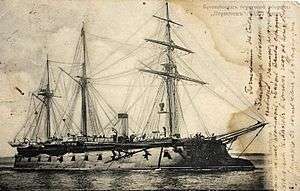Pervenets-class ironclad
The Pervenets-class ironclads were a group of three armored frigates built for the Imperial Russian Navy in the 1860s. The first ship was built in England because the Russian Empire lacked the ability to build its own ironclads, but the other two were built in Russia. All three ships differed from one another as the design evolved over time. None of the ships ever saw combat and only Kreml had an eventful career, sinking a wooden frigate in an collision in 1869 and sinking herself in 1885. She was refloated and returned to service. They were assigned to the Baltic Fleet upon completion and never left Russian waters. They served with the Gunnery Training Detachment for the bulk of their careers before being reduced to reserve in 1904. They were sold four years later and Pervenets and Ne Tron Menia were converted into coal barges. Pervenets survived World War 2 and was scrapped in the early 1960s, Ne Tron Menia was sunk during the war and scrapped around 1950, while Kreml's fate after her sale is unknown
 A postcard of Pervenets at anchor | |
| Class overview | |
|---|---|
| Name: | Pervenetz |
| Operators: |
|
| Preceded by: | Sevastopol |
| Succeeded by: | Kniaz Pozharsky |
| Built: | 1861–1866 |
| Completed: | 3 |
| Scrapped: | 3 |
| General characteristics (Pervenets as built) | |
| Type: | Armored frigate |
| Displacement: | 3,277 long tons (3,330 t) |
| Length: | 220 ft (67 m) |
| Beam: | 53 ft (16 m) |
| Draft: | 14 ft 6 in (4.42 m) |
| Installed power: |
|
| Propulsion: | 1 shaft, 1 Horizontal direct-action steam engine |
| Speed: | 9 knots (17 km/h; 10 mph) |
| Complement: | 430 officers and crewmen |
| Armament: |
|
| Armor: |
|
Background
The ironclad was developed as a result of the vulnerability of wooden warships to explosive or incendiary shells as demonstrated by the Russian destruction of a Turkish squadron at the Battle of Sinope.[1] The first ironclad battleship, La Gloire, was launched by the French Navy in November 1859.[2] It was followed by the British Warrior-class ironclad. Russia was among the first countries to follow.
Design
The Naval Ministry initially ordered two ships. The first ship in the class, Pervenets (Firstborn), was built in England and the second identical ship, Ne Tron Menia (Don't touch me) in Saint Petersburg. A few months later the decision was made to build a third ship, Kreml (Kremlin), at the Neva shipyards in Saint Petersburg.[1]
The ships were smaller and slower than the contemporary British HMS Warrior and French La Gloire, and were in fact designated "Armored Battery", rather "Armored Frigate", such as the later Admiral Lazarev class. They had the same 114-millimetre (4.5 in) armour as Warrior. Kreml had a few modifications such as a teak layer under the armor and design-planned later upgrade to the 203-millimetre (8 in) guns.[1]
Ships
| Ship | Builder[3] | Ordered[3] | Construction began[3] | Laid down[3][Note 1] | Launched[3] | Entered service[3] | Fate[3] | Cost (hull and machinery only)[3] |
|---|---|---|---|---|---|---|---|---|
| Pervenets | Thames Iron Works, Blackwall, London | 18 November 1861[Note 2] | December 1861 | 18 May 1863 | 28 July 1864 | Scrapped, 1960s | 917,000 rubles | |
| Ne Tron Menia | Charles Mitchell Shipyard, St. Petersburg | 31 March 1862 | 30 January 1863 | 1 December 1863 | 23 June 1864 | 18 July 1865 | Scrapped, 1950 | 923,500 rubles |
| Kreml | Semiannikov & Poletika, St. Petersburg | 20 April 1863 | 2 October 1863 | 23 December 1863 | 26 August 1865 | 1866 | Unknown | 898,000 |
Service history
All three ships served in the Baltic Fleet. They never saw any combat action, and gradually transferred from combat ships to training and coastal defence ships. The last ship in the class, Kreml suffered several serious accidents, accidentally scuttling the frigate Orel in 1869. Kreml itself sank due to a storm on 29 May 1885, although she was recovered five days later and returned to service. The last ship of the class, she was scrapped in October 1905.[1]
Notes
Footnotes
- Military Ships of Russia ISBN 5-89410-001-1, p. 26
- Sondhaus, Lawrence. Naval Warfare 1815–1914 ISBN 0-415-21478-5, pp. 73–4.
- McLaughlin, p. 115
References
- Gardiner, Robert, ed. (1979). Conway's All the World's Fighting Ships 1860–1905. Greenwich, UK: Conway Maritime Press. ISBN 0-8317-0302-4.
- McLaughlin, Stephen (2011). "Russia's First Ironclads: Pervenets, Ne tron menia and Kreml". In Jordan, John (ed.). Warship 2011. London: Conway. pp. 112–29. ISBN 978-1-84486-133-0.
- Silverstone, Paul H. (1984). Directory of the World's Capital Ships. New York: Hippocrene Books. ISBN 0-88254-979-0.
- Watts, Anthony J. (1990). The Imperial Russian Navy. London: Arms and Armour. ISBN 0-85368-912-1.